Bot 本質上是無狀態的。 部署 Bot 之後,它可能不會在相同進程中執行,或從一個回合到下一個回合在同一部電腦上執行。 不過,您的 Bot 可能需要追蹤交談的內容,才能管理其行為,並記住先前問題的解答。 Bot Framework SDK 的狀態和儲存功能可讓您將狀態新增至 Bot。 Bot 會使用狀態管理和儲存物件來管理和保存狀態。 狀態管理員提供抽象層,可讓您使用屬性存取子來存取狀態屬性,與基礎記憶體類型無關。
收到使用者輸入時,此範例會檢查儲存的交談狀態,以查看此使用者先前是否已提示您提供其名稱。 如果沒有,則會要求使用者的名稱,且該輸入會儲存在用戶狀態內。 如果是的話,儲存在用戶狀態內的名稱會用來與使用者及其輸入數據進行交談,以及接收的時間和輸入通道標識碼,會傳回給使用者。 時間與通道標識碼值會從使用者交談數據擷取,然後儲存至交談狀態。 下圖顯示 Bot、使用者配置檔和交談數據類別之間的關聯性。
設定狀態管理的第一個步驟是定義類別,其中包含在使用者和交談狀態中管理的資訊。 本文中使用的範例會定義下列類別:
- 在 UserProfile.cs中,您會為 Bot 將收集的使用者資訊定義類別
UserProfile 。
- 在 ConversationData.cs中,您會定義類別
ConversationData ,以在收集用戶資訊時控制我們的交談狀態。
下列程式代碼範例顯示和 ConversationData 類別的定義UserProfile。
UserProfile.cs
public class UserProfile
{
public string Name { get; set; }
}
ConversationData.cs
public class ConversationData
{
// The time-stamp of the most recent incoming message.
public string Timestamp { get; set; }
// The ID of the user's channel.
public string ChannelId { get; set; }
// Track whether we have already asked the user's name
public bool PromptedUserForName { get; set; } = false;
}
設定狀態管理的第一個步驟是定義類別,其中包含在使用者和交談狀態中管理的資訊。 本文中使用的範例會定義下列類別:
- 在 UserProfile.java中,您可以定義
UserProfile Bot 將收集之使用者資訊的類別。
- 在 ConversationData.java中,您會定義類別
ConversationData ,以在收集用戶資訊時控制我們的交談狀態。
下列程式代碼範例顯示和 ConversationData 類別的定義UserProfile。
UserProfile.java
public class UserProfile {
private String name;
public String getName() {
return name;
}
public void setName(String withName) {
name = withName;
}
}
ConversationData.java
public class ConversationData {
// The time-stamp of the most recent incoming message.
private String timestamp;
// The ID of the user's channel.
private String channelId;
// Track whether we have already asked the user's name.
private boolean promptedUserForName = false;
public String getTimestamp() {
return timestamp;
}
public void setTimestamp(String withTimestamp) {
timestamp = withTimestamp;
}
public String getChannelId() {
return channelId;
}
public void setChannelId(String withChannelId) {
channelId = withChannelId;
}
public boolean getPromptedUserForName() {
return promptedUserForName;
}
public void setPromptedUserForName(boolean withPromptedUserForName) {
設定狀態管理的第一個步驟是定義類別,其中包含在使用者和交談狀態中管理的資訊。 本文中使用的範例會定義下列類別:
- user_profile.py包含
UserProfile類別,可儲存 Bot 所收集的用戶資訊。
- conversation_data.py包含類別,
ConversationData可在收集用戶資訊時控制交談狀態。
下列程式代碼範例顯示和 ConversationData 類別的定義UserProfile。
user_profile.py
class UserProfile:
def __init__(self, name: str = None):
self.name = name
conversation_data.py
class ConversationData:
def __init__(
self,
timestamp: str = None,
channel_id: str = None,
prompted_for_user_name: bool = False,
):
self.timestamp = timestamp
self.channel_id = channel_id
self.prompted_for_user_name = prompted_for_user_name
接下來,您會註冊 MemoryStorage 用來建立 UserState 和 ConversationState 物件的 。 使用者和交談狀態物件會在 中 Startup 建立,並將相依性插入 Bot 建構函式中。 已註冊 Bot 的其他服務包括:認證提供者、配接器和 Bot 實作。
Startup.cs
// {
// TypeNameHandling = TypeNameHandling.All,
// var storage = new BlobsStorage("<blob-storage-connection-string>", "bot-state");
// With a custom JSON SERIALIZER, use this instead.
// var storage = new BlobsStorage("<blob-storage-connection-string>", "bot-state", jsonSerializer);
/* END AZURE BLOB STORAGE */
Bots/StateManagementBot.cs
private BotState _conversationState;
private BotState _userState;
public StateManagementBot(ConversationState conversationState, UserState userState)
{
_conversationState = conversationState;
_userState = userState;
}
接下來,您會註冊 MemoryStorage ,然後用來建立 UserState 和 ConversationState 物件。 這些會建立於 index.js 中,並在建立 Bot 時取用。
index.js
const memoryStorage = new MemoryStorage();
// Create conversation and user state with in-memory storage provider.
const conversationState = new ConversationState(memoryStorage);
const userState = new UserState(memoryStorage);
// Create the bot.
const bot = new StateManagementBot(conversationState, userState);
bots/stateManagementBot.js
const CONVERSATION_DATA_PROPERTY = 'conversationData';
const USER_PROFILE_PROPERTY = 'userProfile';
class StateManagementBot extends ActivityHandler {
constructor(conversationState, userState) {
super();
// Create the state property accessors for the conversation data and user profile.
this.conversationDataAccessor = conversationState.createProperty(CONVERSATION_DATA_PROPERTY);
this.userProfileAccessor = userState.createProperty(USER_PROFILE_PROPERTY);
// The state management objects for the conversation and user state.
this.conversationState = conversationState;
this.userState = userState;
接下來,您會在 Application.java 中註冊 StateManagementBot 。 根據預設,ConversationState 和 UserState 都是從 BotDependencyConfiguration 類別提供,Spring 會將它們插入 getBot 方法中。
Application.java
@Bean
public Bot getBot(
ConversationState conversationState,
UserState userState
) {
return new StateManagementBot(conversationState, userState);
}
接下來,您會註冊 MemoryStorage 用來建立 UserState 和 ConversationState 物件的 。 這些會在建立 Bot 時於 app.py 中建立並取用。
app.py
CONVERSATION_STATE = ConversationState(MEMORY)
# Create Bot
BOT = StateManagementBot(CONVERSATION_STATE, USER_STATE)
# Listen for incoming requests on /api/messages.
bots/state_management_bot.py
def __init__(self, conversation_state: ConversationState, user_state: UserState):
if conversation_state is None:
raise TypeError(
"[StateManagementBot]: Missing parameter. conversation_state is required but None was given"
)
if user_state is None:
raise TypeError(
"[StateManagementBot]: Missing parameter. user_state is required but None was given"
)
self.conversation_state = conversation_state
self.user_state = user_state
self.conversation_data_accessor = self.conversation_state.create_property(
"ConversationData"
)
self.user_profile_accessor = self.user_state.create_property("UserProfile")
現在,您可以使用 方法建立屬性存取子 CreateProperty ,以提供 物件的句柄 BotState 。 每個狀態屬性存取子都可讓您取得或設定相關聯狀態屬性的值。 使用狀態屬性之前,請先使用每個存取子從記憶體載入屬性,並從狀態快取中取得屬性。 若要取得與 state 屬性相關聯的適當範圍索引鍵,您可以呼叫 GetAsync 方法。
Bots/StateManagementBot.cs
var conversationStateAccessors = _conversationState.CreateProperty<ConversationData>(nameof(ConversationData));
var userStateAccessors = _userState.CreateProperty<UserProfile>(nameof(UserProfile));
現在,您會為 UserState 和 ConversationState建立屬性存取子。 每個狀態屬性存取子都可讓您取得或設定相關聯狀態屬性的值。 您可以使用每個存取子從記憶體載入相關聯的屬性,並從快取擷取其目前狀態。
bots/stateManagementBot.js
// Create the state property accessors for the conversation data and user profile.
this.conversationDataAccessor = conversationState.createProperty(CONVERSATION_DATA_PROPERTY);
this.userProfileAccessor = userState.createProperty(USER_PROFILE_PROPERTY);
現在您會使用 createProperty 方法建立屬性存取子。 每個狀態屬性存取子都可讓您取得或設定相關聯狀態屬性的值。 使用狀態屬性之前,請先使用每個存取子從記憶體載入屬性,並從狀態快取中取得屬性。 若要取得與 state 屬性相關聯的適當範圍索引鍵,您可以呼叫 get 方法。
StateManagementBot.java
StatePropertyAccessor<ConversationData> dataAccessor =
conversationState.createProperty("data");
CompletableFuture<ConversationData> dataFuture =
dataAccessor.get(turnContext, ConversationData::new);
現在,您會為 UserProfile 和 ConversationData建立屬性存取子。 每個狀態屬性存取子都可讓您取得或設定相關聯狀態屬性的值。 您可以使用每個存取子從記憶體載入相關聯的屬性,並從快取擷取其目前狀態。
bots/state_management_bot.py
self.conversation_data_accessor = self.conversation_state.create_property(
"ConversationData"
)
self.user_profile_accessor = self.user_state.create_property("UserProfile")
- 如果
userProfile.Name 為空白且 conversationData.PromptedUserForName 為 true,則您會擷取所提供的用戶名稱,並將它儲存在用戶狀態內。
- 如果
userProfile.Name 是空的,且 conversationData.PromptedUserForName 為 false,則您要求用戶的名稱。
- 如果
userProfile.Name 先前已儲存,您會從使用者輸入擷取訊息時間和通道標識碼、將所有數據回顯回給使用者,並將擷取的數據儲存在交談狀態中。
Bots/StateManagementBot.cs
protected override async Task OnMessageActivityAsync(ITurnContext<IMessageActivity> turnContext, CancellationToken cancellationToken)
{
// Get the state properties from the turn context.
var conversationStateAccessors = _conversationState.CreateProperty<ConversationData>(nameof(ConversationData));
var conversationData = await conversationStateAccessors.GetAsync(turnContext, () => new ConversationData());
var userStateAccessors = _userState.CreateProperty<UserProfile>(nameof(UserProfile));
var userProfile = await userStateAccessors.GetAsync(turnContext, () => new UserProfile());
if (string.IsNullOrEmpty(userProfile.Name))
{
// First time around this is set to false, so we will prompt user for name.
if (conversationData.PromptedUserForName)
{
// Set the name to what the user provided.
userProfile.Name = turnContext.Activity.Text?.Trim();
// Acknowledge that we got their name.
await turnContext.SendActivityAsync($"Thanks {userProfile.Name}. To see conversation data, type anything.");
// Reset the flag to allow the bot to go through the cycle again.
conversationData.PromptedUserForName = false;
}
else
{
// Prompt the user for their name.
await turnContext.SendActivityAsync($"What is your name?");
// Set the flag to true, so we don't prompt in the next turn.
conversationData.PromptedUserForName = true;
}
}
else
{
// Add message details to the conversation data.
// Convert saved Timestamp to local DateTimeOffset, then to string for display.
var messageTimeOffset = (DateTimeOffset)turnContext.Activity.Timestamp;
var localMessageTime = messageTimeOffset.ToLocalTime();
conversationData.Timestamp = localMessageTime.ToString();
conversationData.ChannelId = turnContext.Activity.ChannelId.ToString();
// Display state data.
await turnContext.SendActivityAsync($"{userProfile.Name} sent: {turnContext.Activity.Text}");
await turnContext.SendActivityAsync($"Message received at: {conversationData.Timestamp}");
await turnContext.SendActivityAsync($"Message received from: {conversationData.ChannelId}");
}
}
結束回合處理程式之前,您會使用狀態管理物件的 SaveChangesAsync() 方法來將所有狀態變更寫回記憶體。
Bots/StateManagementBot.cs
public override async Task OnTurnAsync(ITurnContext turnContext, CancellationToken cancellationToken = default(CancellationToken))
{
await base.OnTurnAsync(turnContext, cancellationToken);
// Save any state changes that might have occurred during the turn.
await _conversationState.SaveChangesAsync(turnContext, false, cancellationToken);
await _userState.SaveChangesAsync(turnContext, false, cancellationToken);
}
- 如果
userProfile.Name 為空白且 conversationData.PromptedUserForName 為 true,則您會擷取所提供的用戶名稱,並將它儲存在用戶狀態內。
- 如果
userProfile.Name 是空的,且 conversationData.PromptedUserForName 為 false,則您要求用戶的名稱。
- 如果
userProfile.Name 先前已儲存,您會從使用者輸入擷取訊息時間和通道標識碼、將所有數據回顯回給使用者,並將擷取的數據儲存在交談狀態中。
bots/stateManagementBot.js
this.onMessage(async (turnContext, next) => {
// Get the state properties from the turn context.
const userProfile = await this.userProfileAccessor.get(turnContext, {});
const conversationData = await this.conversationDataAccessor.get(
turnContext, { promptedForUserName: false });
if (!userProfile.name) {
// First time around this is undefined, so we will prompt user for name.
if (conversationData.promptedForUserName) {
// Set the name to what the user provided.
userProfile.name = turnContext.activity.text;
// Acknowledge that we got their name.
await turnContext.sendActivity(`Thanks ${ userProfile.name }. To see conversation data, type anything.`);
// Reset the flag to allow the bot to go though the cycle again.
conversationData.promptedForUserName = false;
} else {
// Prompt the user for their name.
await turnContext.sendActivity('What is your name?');
// Set the flag to true, so we don't prompt in the next turn.
conversationData.promptedForUserName = true;
}
} else {
// Add message details to the conversation data.
conversationData.timestamp = turnContext.activity.timestamp.toLocaleString();
conversationData.channelId = turnContext.activity.channelId;
// Display state data.
await turnContext.sendActivity(`${ userProfile.name } sent: ${ turnContext.activity.text }`);
await turnContext.sendActivity(`Message received at: ${ conversationData.timestamp }`);
await turnContext.sendActivity(`Message received from: ${ conversationData.channelId }`);
}
// By calling next() you ensure that the next BotHandler is run.
await next();
});
結束每個對話框回合之前,您會使用狀態管理物件的 saveChanges() 方法來保存所有變更,方法是將狀態寫回記憶體。
bots/stateManagementBot.js
/**
* Override the ActivityHandler.run() method to save state changes after the bot logic completes.
*/
async run(context) {
await super.run(context);
// Save any state changes. The load happened during the execution of the Dialog.
await this.conversationState.saveChanges(context, false);
await this.userState.saveChanges(context, false);
}
- 如果
userProfile.getName() 為空白且 conversationData.getPromptedUserForName() 為 true,則您會擷取所提供的用戶名稱,並將它儲存在用戶狀態內。
- 如果
userProfile.getName() 是空的,且 conversationData.getPromptedUserForName() 為 false,則您要求用戶的名稱。
- 如果
userProfile.getName() 先前已儲存,您會從使用者輸入擷取訊息時間和通道標識碼、將所有數據回顯回給使用者,並將擷取的數據儲存在交談狀態中。
StateManagementBot.java
@Override
protected CompletableFuture<Void> onMessageActivity(TurnContext turnContext) {
// Get state data from ConversationState.
StatePropertyAccessor<ConversationData> dataAccessor =
conversationState.createProperty("data");
CompletableFuture<ConversationData> dataFuture =
dataAccessor.get(turnContext, ConversationData::new);
// Get profile from UserState.
StatePropertyAccessor<UserProfile> profileAccessor = userState.createProperty("profile");
CompletableFuture<UserProfile> profileFuture =
profileAccessor.get(turnContext, UserProfile::new);
return dataFuture.thenCombine(profileFuture, (conversationData, userProfile) -> {
if (StringUtils.isBlank(userProfile.getName())) {
// First time around this is set to false, so we will prompt user for name.
if (conversationData.getPromptedUserForName()) {
// Reset the flag to allow the bot to go though the cycle again.
conversationData.setPromptedUserForName(false);
// Set the name to what the user provided and reply.
userProfile.setName(turnContext.getActivity().getText());
// Acknowledge that we got their name.
return turnContext.sendActivity(
MessageFactory.text(
"Thanks " + userProfile.getName()
+ ". To see conversation data, type anything."
)
);
} else {
// Set the flag to true, so we don't prompt in the next turn.
conversationData.setPromptedUserForName(true);
// Prompt the user for their name.
return turnContext.sendActivity(MessageFactory.text("What is your name?"));
}
} else {
OffsetDateTime messageTimeOffset = turnContext.getActivity().getTimestamp();
LocalDateTime localMessageTime = messageTimeOffset.toLocalDateTime();
//Displaying current date and time in 12 hour format with AM/PM
DateTimeFormatter dateTimeAMPMFormat = DateTimeFormatter.ofPattern("MM/dd/yyyy, hh:mm:ss a");
conversationData.setTimestamp(dateTimeAMPMFormat.format(localMessageTime));
conversationData.setChannelId(turnContext.getActivity().getChannelId());
List<Activity> sendToUser = new ArrayList<>();
sendToUser.add(
MessageFactory.text(
userProfile.getName() + " sent: " + turnContext.getActivity().getText()
)
);
sendToUser.add(
MessageFactory.text("Message received at: " + conversationData.getTimestamp()
)
);
sendToUser.add(
MessageFactory.text("Message received from: " + conversationData.getChannelId()
)
);
return turnContext.sendActivities(sendToUser);
}
})
// make the return value happy.
.thenApply(resourceResponse -> null);
}
結束回合處理程式之前,您會使用狀態管理物件的 saveChanges() 方法來將所有狀態變更寫回記憶體。
StateManagementBot.java
@Override
public CompletableFuture<Void> onTurn(TurnContext turnContext) {
return super.onTurn(turnContext)
// Save any state changes that might have occurred during the turn.
.thenCompose(turnResult -> conversationState.saveChanges(turnContext))
.thenCompose(saveResult -> userState.saveChanges(turnContext));
}
- 如果
user_profile.name 為空白且 conversation_data.prompted_for_user_name 為 true,則 Bot 會擷取使用者提供的名稱,並將其儲存在用戶的狀態。
- 如果
user_profile.name 為空白且 conversation_data.prompted_for_user_name 為 false,則 Bot 會要求用戶的名稱。
- 如果
user_profile.name 先前已儲存,Bot 會從使用者輸入擷取訊息時間和通道標識碼、將數據回應給使用者,並將擷取的數據儲存在交談狀態中。
bots/state_management_bot.py
async def on_message_activity(self, turn_context: TurnContext):
# Get the state properties from the turn context.
user_profile = await self.user_profile_accessor.get(turn_context, UserProfile)
conversation_data = await self.conversation_data_accessor.get(
turn_context, ConversationData
)
if user_profile.name is None:
# First time around this is undefined, so we will prompt user for name.
if conversation_data.prompted_for_user_name:
# Set the name to what the user provided.
user_profile.name = turn_context.activity.text
# Acknowledge that we got their name.
await turn_context.send_activity(
f"Thanks { user_profile.name }. To see conversation data, type anything."
)
# Reset the flag to allow the bot to go though the cycle again.
conversation_data.prompted_for_user_name = False
else:
# Prompt the user for their name.
await turn_context.send_activity("What is your name?")
# Set the flag to true, so we don't prompt in the next turn.
conversation_data.prompted_for_user_name = True
else:
# Add message details to the conversation data.
conversation_data.timestamp = self.__datetime_from_utc_to_local(
turn_context.activity.timestamp
)
conversation_data.channel_id = turn_context.activity.channel_id
# Display state data.
await turn_context.send_activity(
f"{ user_profile.name } sent: { turn_context.activity.text }"
)
await turn_context.send_activity(
f"Message received at: { conversation_data.timestamp }"
)
await turn_context.send_activity(
f"Message received from: { conversation_data.channel_id }"
)
在每個對話框回合結束之前,Bot 會使用狀態管理物件的 save_changes 方法,在記憶體中寫入狀態資訊來保存所有變更。
bots/state_management_bot.py
async def on_turn(self, turn_context: TurnContext):
await super().on_turn(turn_context)
await self.conversation_state.save_changes(turn_context)
await self.user_state.save_changes(turn_context)


